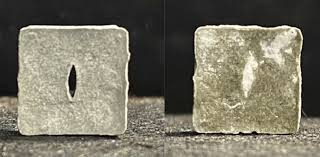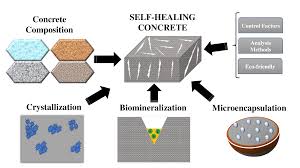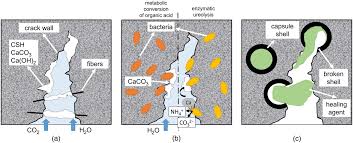
What is Self-Healing Concrete?
Self-healing concrete is a revolutionary material that has the ability to repair its own cracks and damages over time, without human intervention. This innovation aims to extend the lifespan of concrete structures, reduce maintenance costs, and improve the sustainability of construction projects. By integrating special healing agents into the concrete mix, self-healing concrete can automatically respond to the formation of cracks by initiating a repair process.
How Does Self-Healing Concrete Work?

Self-healing concrete typically relies on one of the following mechanisms:
- Microencapsulation of Healing Agents:
- In this method, tiny capsules containing healing agents (such as bacteria, epoxy resins, or mineral-based solutions) are embedded within the concrete. When cracks form, these capsules break open, releasing the healing agents that fill and seal the cracks.
- For example, certain types of bacteria in the concrete can become activated in the presence of water and air, producing calcium carbonate to fill cracks.
- Bacterial-Based Healing:
- In this form of self-healing concrete, bacteria (often Bacillus species) are mixed into the concrete during the mixing process. These bacteria are dormant initially, but when cracks form and water enters, they become active and produce calcium carbonate, which helps to close the cracks.
- The bacteria remain in a dormant state for years, only activating when cracks occur, allowing the concrete to self-repair long after the concrete has hardened.
- Vascular System:
- A vascular system is incorporated into the concrete, where channels or tubes are embedded in the mix. These channels can be filled with healing agents (such as resin or grout) that are activated when cracks form. When a crack opens, the fluid is released from the channels to fill and heal the damage.
- This method is designed to allow the healing agents to flow directly into the cracks, effectively sealing them and preventing further damage.
- Crystallization:
- Some self-healing concrete uses crystallizing compounds that react with water and air to form crystals. When cracks develop, these compounds react with moisture to create new crystals, which block the crack and prevent water infiltration.
- The crystals grow over time, effectively sealing the crack and restoring the material’s structural integrity.
Benefits of Self-Healing Concrete

- Increased Durability:
- Self-healing concrete significantly enhances the durability of structures by preventing the progressive damage that typically occurs over time. Cracks, which often allow water and corrosive elements to penetrate, are sealed, reducing the risk of further degradation.
- Reduced Maintenance Costs:
- By repairing cracks automatically, the need for regular inspections and repairs is minimized. This reduces labor costs and the expense of maintaining concrete structures. It also helps extend the lifespan of buildings, bridges, roads, and other infrastructure.
- Sustainability:
- The ability to repair itself means less concrete needs to be replaced over time, leading to less waste and a reduced environmental footprint. Additionally, self-healing concrete can reduce the need for the production of new concrete, which is energy-intensive and emits a significant amount of carbon dioxide.
- Increased Safety:
- Concrete is widely used in critical infrastructure, such as bridges, highways, and tunnels. Self-healing concrete can help prevent further damage from cracks, reducing the risk of structural failure and enhancing safety for the public.
- Enhanced Resistance to Water Damage:
- Since cracks in concrete can often lead to water infiltration, which can weaken the material and lead to corrosion of reinforcing steel, self-healing concrete provides enhanced resistance to water damage by sealing cracks as soon as they form.
Challenges and Limitations
- Initial Cost:
- The production of self-healing concrete is still relatively expensive compared to traditional concrete. The cost of integrating bacteria, capsules, or special compounds may make it less attractive for some projects, especially for low-budget or small-scale developments.
- Effectiveness Over Time:
- While self-healing concrete can repair small cracks, the healing process may not be effective for large or structural cracks that significantly compromise the integrity of the concrete. The long-term effectiveness of some self-healing methods, particularly bacterial-based healing, is still being studied.
- Limitations in Application:
- Not all types of cracks can be healed effectively. For instance, cracks that are too large or that form in areas with high mechanical stresses might not benefit from self-healing properties. The technology is still being developed for more complex, high-performance applications.
- Environmental Factors:
- The success of self-healing concrete can depend on the environmental conditions. For example, bacterial-based systems rely on moisture to activate the bacteria, so they may not work effectively in very dry conditions.
- Regulatory Approval:
- In some regions, new materials like self-healing concrete must go through rigorous testing and certification before being used in large-scale infrastructure projects. Regulatory hurdles can slow the adoption of this technology.
Current Developments and Applications
Several research institutions, startups, and construction companies are actively working on improving and commercializing self-healing concrete. Some notable developments include:
- Bacterial Self-Healing Concrete:
- The University of Nottingham (UK) has developed a bacterial-based self-healing concrete that incorporates Bacillus bacteria. This concrete has been tested in real-world applications and has shown promise in extending the lifespan of concrete structures by decades.
- U.S. and European Research Projects:
- Several government-funded projects in the U.S. and Europe are exploring different ways to incorporate self-healing materials into concrete. These projects focus on improving the sustainability and cost-effectiveness of self-healing concrete, with a view toward widespread commercialization.
- Dutch Innovations:
- The Netherlands is a leader in using self-healing concrete for infrastructure projects. Researchers at Delft University of Technology have developed several versions of self-healing concrete, including the use of bio-based materials and polymer-based healing agents.
- Commercialization and Pilot Projects:
- Companies like Cementitious Materials and BioMason are working on scaling up self-healing concrete production. Pilot projects for bridges and roadways are already being planned in various countries, showcasing the potential for long-term savings in maintenance costs.
The Future of Self-Healing Concrete

Self-healing concrete is expected to play an important role in the future of sustainable construction, as it can help reduce the environmental impact of concrete, improve the durability of infrastructure, and lower maintenance costs. Ongoing research and technological advancements will likely make it more affordable and efficient in the coming years, making it an increasingly viable option for a wide range of construction projects.
In the future, we may see more widespread adoption of self-healing concrete in urban development, particularly in high-stress environments like bridges, roads, and airports. As the technology matures, it could even become the standard material for new construction, leading to safer, more durable buildings and infrastructure.
Conclusion
Self-healing concrete represents a significant advancement in construction materials, offering enhanced durability, sustainability, and safety. While there are challenges to overcome—such as cost and long-term effectiveness—the technology holds great promise for revolutionizing the way we build and maintain infrastructure. With continued research and development, self-healing concrete may become a common solution for addressing the pressing issues of concrete degradation and infrastructure maintenance.
